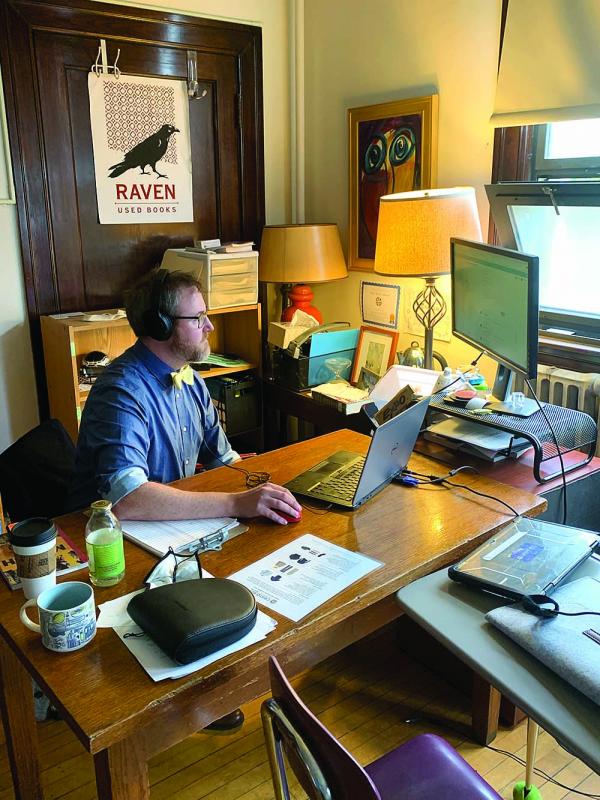September 16, 2020

Mike Kauffmann, an English teacher at Cristo Rey Boston high school and a Savin Hill resident, is shown at his desk. Photo courtesy Cristo Rey Boston
There are variations depending on the system— public, charter, private or parochial. But, all teachers in Boston schools are adapting to the shifting demands of covid-era instruction this month.
At Pope John Paul II Catholic Academy’s Columbia campus, roughly 60 percent of K-8 students are back in classrooms since re-opening for in-person learning on Sept. 9.
Claire Barton Sheridan, the campus principal, says that the remaining students chose to learn from home— and are monitoring classrooms via laptops and tablet.
“The kids are doing fantastic, attendance has been excellent and they are being very good about following the rules,” said Sheridan. “We’ve worked very hard all summer to make sure that the building was set for each of the kids to come back successfully.”
Teachers participated in professional development throughout the summer, she said.
“Communication was key, all of our parents would get a communication from the principal each week outlining where we were at that time and what our hope was in moving forward.
Everyone knew that it was a fluid situation and things could change, but that’s okay, no stress. We will deal with it if there’s a concern and we have plans in place for everything that you could think of just in case.”
At the McCormack Middle School on Mt. Vernon Street, teachers and staff continue to prepare for the launch of online-only classes on Sept. 21. Monique Symes, a 7th grade English teacher at the BPS school, said she and her colleagues are spending five to six hours a day on professional development through Sept. 18.
“At the McCormack, we’re hoping that between Monday and Wednesday we connect with all, if not almost all of our families through our town halls,” said Symes. “The focus of our initial communication is to make sure that everybody knows that all students will start school online on the 21st.”
Symes said she has heard rumblings that teachers do not want to go back into school buildings. She disputes that, but acknowledges that many do have concerns about how to track air quality.
“We haven’t seen a lot of information around how that’s going to be assessed and sustained throughout the time that we’re supposed to be in the building,” she said. “Teachers definitely want to go back to school, but we also want to make sure that it’s safe.”
Shannon Casey, a Dorchester resident who teaches at the BPS Curley in Jamaica Plain, agrees.
“Some people think that teachers don’t want to go back. But everyone that I know who is healthy and doesn’t have health concerns wants to be back,” she said.
Casey has been juggling class lists, preparing family and student outreach, and deciding which remote platforms to use.
“It’s easier if the whole school is using the same platforms because we obviously have families with multiple students in different grades and it just becomes overwhelming,” Casey said.
During upcoming open houses, Casey said teachers will focus on asking families what resources and supplies they need.
“Whether that be some time with a school counselor, meals, chrome books, whatever they need,” she told the Reporter. “We’ve just started to focus on lesson planning and planned our first day today, which took off a lot of pressure.”
Casey said she’s concerned about screen fatigue for both students and teachers—and also about making sure kids have the tools they need at home.
“Being able to distribute supplies is probably the concern that’s at the top of my list. We just don’t know who the responsibility falls on of distributing them and we know that we won’t be able to dive deep into curriculum while staying under the minute limits because if they don’t have a book, manipulative, or even just a notebook or pencil to be writing their work down then we’re going to have to sub that out with something virtual,” she said.
Mike Kauffmann, an English teacher at Cristo Rey Boston on Savin Hill Avenue, sees a silver lining to the new “hybrid” model. Survey results at Cristo Rey— which has been open longer than most schools in the city— have shown that some students actually prefer remote learning, while others have trouble focusing at home.
“In most of my classes I have about 6 kids live, and depending on the size of the class, I have about 14 to 18 remote. Teaching both at the same time can be really challenging and there isn’t really a model of what it would look like to do both, so it’s kind of an uncharted territory there,” he said.
“It’s a weird balance, because the fewer students we have in the building the less risk for everyone in the building, the longer the building might be open. At the same time, you miss having a bunch of other people and students in the building, but there are just so many complexities to consider for all of the families. I try to respect whatever it is families have to do to stay safe.”
Kauffman said he would be remiss if the technology developed for remote learning isn’t incorporated in the future to make learning better.
“I hope that once everyone is safe and feeling secure in their needs and their loved ones are cared for, I hope we can look at some of the questions that remote teaching has made us ask,” he said.
“I’d be sad if in a year from now, every classroom looked just like it did in 2018 or 2019. I hope there is something positive that comes out of all of this.”


